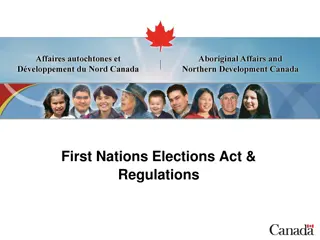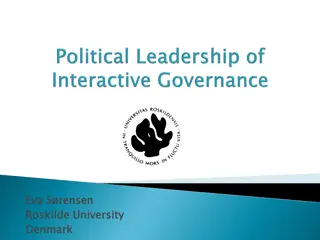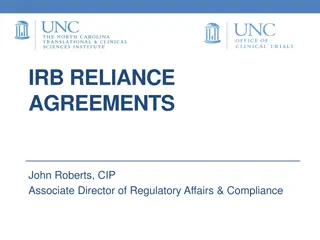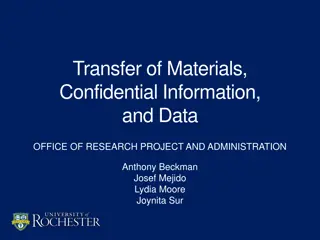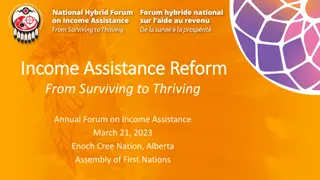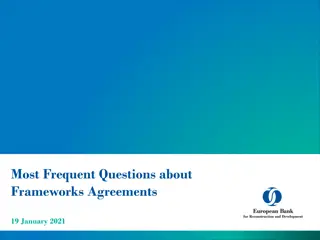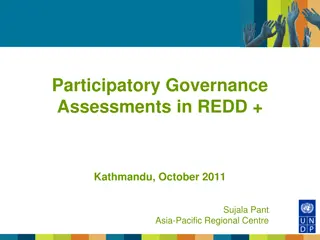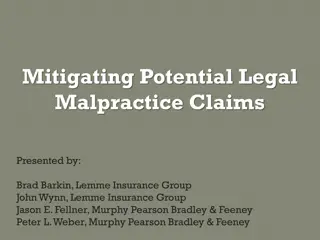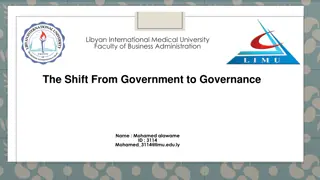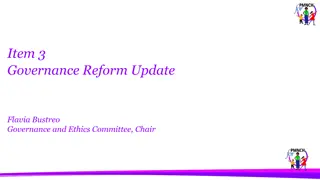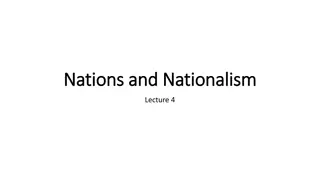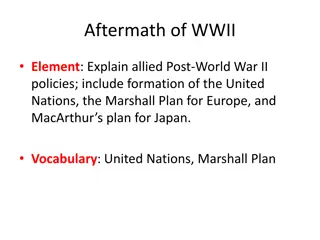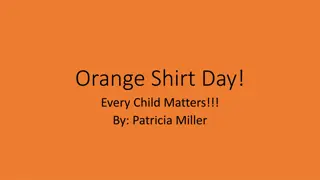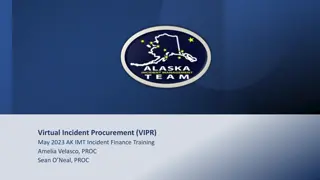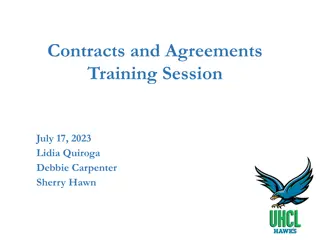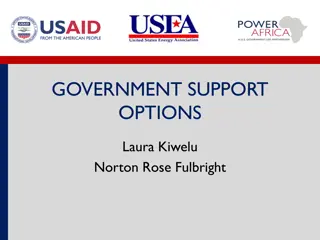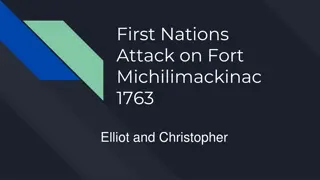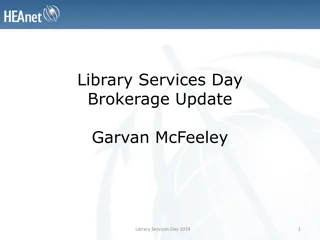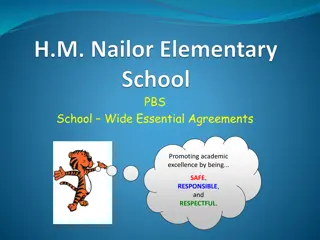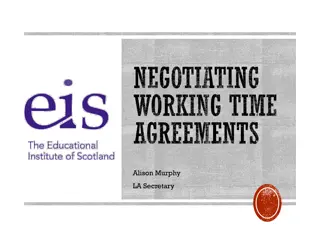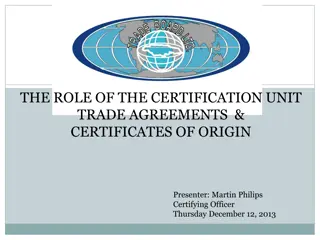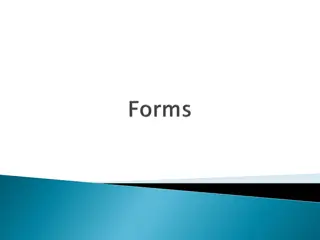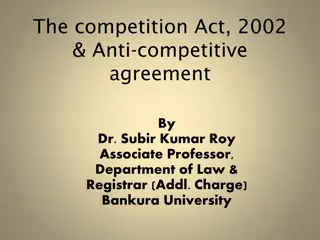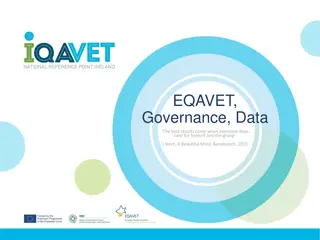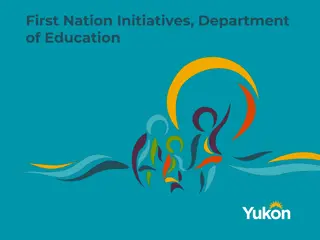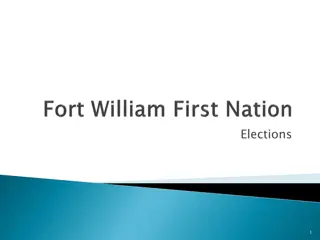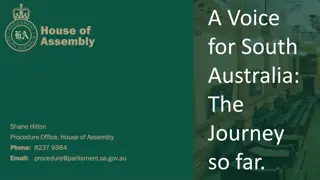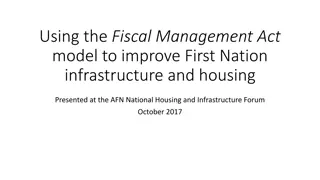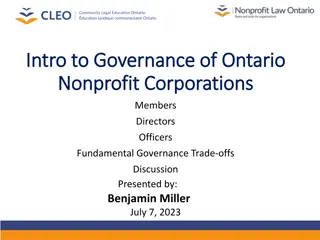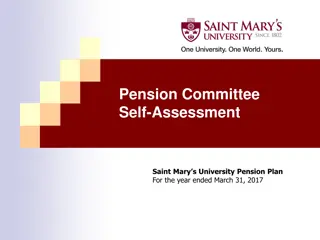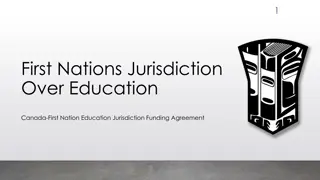Understanding First Nations Education Governance Agreements
Explore the Canada-First Nations Education Jurisdiction Agreement and its significance, including the framework, funding, and key agreements with British Columbia. Learn about the self-government rights of Indigenous peoples and the importance of sectoral agreements in education governance.
Download Presentation

Please find below an Image/Link to download the presentation.
The content on the website is provided AS IS for your information and personal use only. It may not be sold, licensed, or shared on other websites without obtaining consent from the author. Download presentation by click this link. If you encounter any issues during the download, it is possible that the publisher has removed the file from their server.
E N D
Presentation Transcript
1 First Nations Jurisdiction Over Education The Canada-First Nations Education Jurisdiction Agreement
2 Suggested Procedure for Discussion and Questions After each section there will be an allotted time for questions and discussion. If questions come up during the slides, please record them in the Zoom chat and they will be collected by the discussion moderators.
3 Presentation Overview Overview of Jurisdiction Agreement Background on Sectoral Self-Government Agreements Outline of The Canada-First Nation Education Jurisdiction Agreement
4 Overview of Agreements 4
5 Overview of Jurisdiction Agreements First Nations, FNESC, Canada, BC, and FNEA have negotiated a number of agreements that support the effective implementation of the Jurisdiction Agreements between Canada and PFNs. The following slides provide a high level overview of the agreements among the various parties.
6 Overview of Key Jurisdiction Agreements First Nations Education Jurisdiction Framework Agreement (2023) Jurisdiction agreements with BC This Framework Agreement has two schedules: There are 3 agreements with BC: Canada - First Nation Education Jurisdiction Agreement Canada - First Nation Education Jurisdiction Funding Agreement BC FNEA Agreement BC - PFN Agreement BC - FNESC Agreement
7 Canada - First Nation Education Jurisdiction Agreement (Jurisdiction Agreement) Canada - First Nation Education Jurisdiction Funding Agreement (Funding Agreement) This is the Sectoral Self- government Agreement between Canada and individual PFNs. This funding agreement is intended to support the implementation of the Jurisdiction Agreement. It sets out how Canada will fund a PFN to meet its responsibilities under the Jurisdiction Agreement. It recognizes a PFN s law-making authority and sets out the parties responsibilities. The Funding Agreement must be approved by Chief and Council. The Jurisdiction Agreement must be ratified by a First Nation s community members.
8 Background on Sectoral Self-Government Agreements Indigenous peoples have an inherent right to self-government, as recognized under section 35 of the Constitution Act, 1982. Sectoral Self-Government Agreements are agreements between Canada and First Nations that recognize self-government over a specific sector, such as education. These agreements describe how Indigenous groups exercise their inherent right, including their jurisdiction (i.e. law-making authority). They include arrangements for Indigenous groups to govern their internal affairs and assume greater responsibility and control over the decision-making that affects their communities.
9 Canada - First Nation Education Jurisdiction Agreement (Jurisdiction Agreement) The Jurisdiction Agreement is a sectoral self-government agreement. The parties to the Jurisdiction Agreement are: Canada, represented by the Minister of Crown-Indigenous Relations ( Canada ), and the Participating First Nation, represented by Chief and Council ( PFN ) A model Jurisdiction Agreement was finalized in May 2022 and four First Nations signed their own individual agreements based on the model. These agreements came into effect on July 1, 2022. Three more First Nations signed individual agreements in 2023 based on the model, which came into effect on July 1, 2023.
10 Overview of the Jurisdiction Agreement The body of the Jurisdiction Agreement is 29 pages long and has a 6 page implementation plan attached. The Jurisdiction Agreement is made up of 11 parts: Part 1 Definitions Part 2 Exercise of Jurisdiction Part 3 Community Education Authority Part 4 First Nations Education Authority
11 Overview of the Jurisdiction Agreement Cont. Part 5 Registry, Enforcement and Adjudication Part 6 Application of Law Part 7 Financial Arrangements Part 8 Implementation Part 9 Dispute Resolution Part 10 Ratification Part 11 General Provisions
12 Whereas Provisions and Part 1 Definitions The whereas provisions provide historical, political and legal context to the Jurisdiction Agreement, but are not legally binding. Part 1 contains the definitions relevant to the agreement.
13 Part 2 Exercise of Jurisdiction The parties recognize PFN s jurisdiction over education on PFN land. This jurisdiction extends to non-member students who attend the PFN s school(s). The PFN agrees to provide kindergarten to grade 12 education to eligible students attending the PFN s school(s). The PFN will also pay for the education of eligible students who are enrolled in a public school, or an independent school or a school operated by or on behalf of Another First Nation, including an online school, alternate education centre, adult education centre, or early childhood learning centre offering an Education program. An eligible student must be resident on the PFN s reserve and must be either: (a) 4 to 21 years old and enrolled in kindergarten to grade 12, or (b) 18 years old or older and enrolled in an adult education program that is funded under the BC Tripartite Education Agreement (BCTEA) or its successor.
14 Part 2 Exercise of Jurisdiction Cont. The PFN also agrees to provide education to students attending the PFN school(s) who live: (a) off-reserve, subject to receiving reciprocal tuition from the Province, and (b) on another First Nation s reserve, subject to receiving funding from or on behalf of that other First Nation. The PFN must provide the parents of non-member students with mechanisms for providing input into decisions that directly and significantly affect the rights of non- member students or their parents. These mechanisms must be included in the PFN s law. The PFN will provide education that supports the transfer of students to and from other schools.
15 Part 2 Exercise of Jurisdiction Cont. The Jurisdiction Agreement confirms the legal status of the PFN and obliges the PFN to exercise its authority in a manner consistent with the agreement, the PFN s laws and the PFN s law-making protocol. The PFN s law-making protocol must include procedures for: passing and amending education laws, challenging the validity of those laws, amending the protocol, and addressing conflicts of interest.
16 Part 2 Exercise of Jurisdiction Cont. The PFN has the authority to pass education laws respecting education it provides on First Nations Land , which includes the authority to do other things as may be necessarily incidental to the exercise of that jurisdiction. The PFN may delegate its law-making authority to the First Nations Education Authority (FNEA). The PFN may delegate its other duties (other than law-making) to another legal entity.
17 Part 3 Community Education Authority Context: One of the most interesting innovations in the Jurisdiction Agreement is that a PFN may, if it chooses to, establish a separate legal entity as its Community Education Authority (CEA) under the sole authority of the First Nation s own education law. Overview of Provisions: The PFN may pass laws establishing a Community Education Authority (CEA) to operate its education system. Such laws must set out the powers, duties, composition and membership of the CEA. Two or more PFNs can establish a single CEA. Where the PFN establishes a CEA, the CEA will have the capacity, rights, powers, and privileges of a natural person as set out in the PFN s law and be bound by that law.
18 Part 3 Community Education Authority Cont. Instead of establishing a CEA under its own law, the PFN may identify an existing or new legal entity established under federal or provincial law as its CEA (e.g. a society under the BC Societies Act). The PFN may provide the CEA with additional powers, but these may not be inconsistent with the law under which the CEA was established as a legal entity. Note: FNESC has additional resources regarding the various pathways First Nations have for implementing jurisdiction over education in their communities.
19 Part 4 First Nations Education Authority (FNEA) Context: The First Nations Education Authority (FNEA) is a regulatory body with a board of Directors appointed by PFNs. A more detailed PPT exists regarding FNEA and the Education Co-Management Agreement. The following slides provide an overview of the provisions relating to FNEA in the Jurisdiction Agreement. Overview of Provisions: On the Effective Date, the PFN must appoint two directors to sit on the collective FNEA board. One of the two directors must be a member of the PFN.
20 Part 4 FNEA Cont. The responsibilities of FNEA include: o assisting the PFN in developing the capacity to provide education, o establishing standards for curriculum and exams for courses provided by the PFN that are necessary to meet graduation requirements, o providing a teacher certification process for teachers in the PFN s school(other than teachers who teach only the PFN s language and culture), and o providing for the certification of the PFN s school(s).
21 Part 4 FNEA Cont. The PFN can only pass its education laws after it has signed the Education Co-Management Agreement with FNEA. The Co-Management Agreement between the PFN and FNEA will address: o FNEA s key responsibilities (i.e. establishing standards and grad requirements, teacher certification and school certification), and o the incorporation by reference in the PFN law of the process, standards and requirements regarding FNEA s key responsibilities. Note: Standards for curriculum and exams for courses required to graduate include both graduation requirements and the process for evaluating locally developed First Nation courses that are required for graduation.
22 Part 5 Registry, Enforcement and Adjudication The PFN must establish and maintain a law registry. When the PFN passes an education law, it must provide copies to Canada and BC. The PFN must establish processes for appeal or review of administrative decisions made by the PFN Council or CEA. Those appeal processes may include an appeal to the BC Supreme Court. Disputes between individuals under a PFN education law may be heard by the BC Supreme Court. The PFN may appoint officials to enforce their education laws. Violations of PFN education laws may be brought before the BC Provincial Court in accordance with summary conviction procedures. The PFN may retain a prosecutor or enter into an agreement with Canada or BC to prosecute offences under PFN education laws.
23 Part 6 Application of Laws Federal laws continue to apply alongside PFN education laws. In the event of a conflict between the two, the PFN law will prevail on PFN land, with some exceptions (e.g. federal laws in relation to matters of overriding national importance). PFN education laws must be consistent with the Jurisdiction Agreement. PFN education laws do not apply to Canada. The Jurisdiction Agreement prevails over the PFN s law-making protocol to the extent of any inconsistency.
24 Part 6 Application of Laws Cont. The Canadian Charter of Rights and Freedoms applies to the PFN and any body (e.g. a CEA) exercising the PFN s jurisdiction and authority over education under the Jurisdiction Agreement. Sections 114 to 122 of the Indian Act will no longer apply to the PFN after it has passed an education law. Note: Sections 114-117 of the Indian Act relate to the following: allowing the federal government to enter into agreements with the provinces and territories for the education of First Nations children; the establishment, operation and maintenance of schools; establishing standards for buildings, equipment, teaching, education, inspection and discipline in connection with schools; transportation; and mandatory attendance. Sections 118-121 have already been repealed. Section 122 provides definitions.
25 Part 7 Financial Arrangements The parties agree to work together to advance certain goals, including closing well-being gaps in education. The parties agree to enter into a Canada-First Nation Education Jurisdiction Funding Agreement ( Funding Agreement ) to enable the PFN to: (a) exercise its rights and carry out its responsibilities set out in the Jurisdiction Agreement, and (b) support the advancement of the goals set out in the Jurisdiction Agreement. Canada s Own-Source Revenue (OSR) Policy will not apply to the calculation of funding under the Funding Agreement (i.e. there will be no OSR offsets deducted from education funding).
26 Part 7 Financial Arrangements Cont. Any funding obligation in the Funding Agreement is subject to appropriation by the federal Parliament. If the PFN does not receive the agreed amount of funding, it does not have to meet its corresponding obligations to provide education. The amount of education program funding provided by Canada to the PFN will not be less than the amount received by First Nations that are not PFNs. If the Funding Agreement is terminated and not replaced, funding for education programs will be provided on the same terms as it was before, and that funding amount will not be less than the amount received by First Nations that are not PFNs.
27 Part 8 Implementation There will be a 10-year implementation plan for the Jurisdiction Agreement, which identifies the parties obligations and how the plan may be amended, renewed or extended. The implementation plan will be attached to the Jurisdiction Agreement, but is not legally binding. On the Effective Date, each of the parties will appoint a senior official to address implementation.
28 Part 9 Dispute Resolution This part sets out the process for resolving disputes that may arise regarding the Jurisdiction Agreement, including negotiation, mediation, and, if the parties agree, arbitration. The parties agree not to take a matter to court until they have tried to resolve it through mediation or, if they have agreed to arbitration, they have received an arbitration decision.
29 Part 10 - Ratification Prior to a ratification vote, the PFN must inform its members of their right to vote, the content of the Jurisdiction Agreement and the content of the law-making protocol. Ratification by the PFN requires that at least 50% of those who cast a vote, vote in favour of entering into the Jurisdiction Agreement and adopting the law-making protocol. o The PFN Council will determine the minimum voting age by resolution. The PFN Council may, by resolution, increase the minimum % required for approval. Ratification by Canada requires that the Minister of Crown-Indigenous Relations (with the authorization of Cabinet) sign the Jurisdiction Agreement and that Cabinet pass an order-in- council adding the name of the PFN to the federal enabling legislation s schedule.
30 Part 11 General Provisions The Jurisdiction Agreement is not a treaty or a land claims agreement within the meaning of sections 25 and 35 of the Constitution Act, 1982 and does not affect the Constitution of Canada. One of the purposes of the Jurisdiction Agreement is to implement elements of the inherent right of self-government recognized and affirmed by section 35 of the Constitution Act, 1982 relating to jurisdiction over education. The Jurisdiction Agreement is to be construed as upholding the rights of Indigenous peoples recognized and affirmed by section 35 of the Constitution Act, 1982, and not as: o creating, amending, defining the nature and scope of, or abrogating or derogating from those rights, o prejudicing, limiting or restricting the position that the parties may take at any time with respect to the aboriginal or treaty rights of the PFN or the exercise of those rights, or o restricting or limiting the PFN from entering into other agreements with Canada or other parties with respect to any matter.
31 Part 11 General Provisions Cont. If the parties are engaged in discussions under a separate inherent right implementation process (e.g. treaty, comprehensive self-government or other negotiations), they will discuss whether there is a need to transition from the exercise of jurisdiction over education under the Jurisdiction Agreement to the exercise of jurisdiction under an agreement negotiated through the other process. o Such discussions would: (a) take place in the context of the other process, (b) consider whether the federal enabling legislation would continue to apply to the PFN, (c) consider whether the Jurisdiction Agreement needs to be amended, replaced or terminated, and (d) address fiscal support for education and related governance responsibilities.
32 Part 11 General Provisions Cont. If a PFN initiates the implementation of the inherent right on its own initiative in a manner that would take it outside the Jurisdiction Agreement (e.g. if it ceases to be an Indian Act band), the parties will meet to discuss whether the Jurisdiction Agreement needs to be amended, replaced or terminated. Nothing in the Jurisdiction Agreement affects the ability of the PFN or its members to participate in federal programs established for Indians, Bands or aboriginal people, in accordance with criteria for those programs.
33 Part 11 General Provisions Cont. Members of the PFN will be eligible to participate in educational programs established by Canada or BC, in accordance with criteria established for those programs, to the extent that the PFN has not assumed responsibility for those programs under a funding agreement. The PFN and Canada will indemnify one another against claims, liabilities and demands arising from their own acts or omissions and those of their officers, employees and agents in the exercise of their powers, duties and functions under the Jurisdiction Agreement. The Jurisdiction Agreement may be amended by consent of the parties. The PFN s consent to any amendment will require a resolution of the PFN Council. Canada s consent may require an Order in Council.
34 Part 11 General Provisions Cont. This Part also contains provisions regarding: access to information and protection of privacy, Canada s international legal obligations, acknowledgement that the Jurisdiction Agreement is the entire agreement between the parties, requirement for any waiver to be in writing, general interpretation rules, calculation of time under the Jurisdiction Agreement, commitment to do what is reasonably required to carry out obligations under the Jurisdiction Agreement, commitment to remedy or amend a provision found by a court to be invalid, illegal or unenforceable, and acknowledgement that the remaining provisions will not be affected, and notices and communications. o o o o o o o o o
35 Education Jurisdiction Resources Community Template PowerPoint Presentation Web Resources (jurisdiction videos, template BCRs and letters, checklist, etc.) Jurisdiction Webpage: http://www.fnesc.ca/about-fnesc/jurisdiction A jurisdiction video file is also available online and is a great resource to provide a historical overview. Jurisdiction Toolkit (under development)
36 Discussion and Questions? 36
37 Thank You If you have any further questions, please contact: Jenna McIver, Coordinator, Executive Services and Jurisdiction Preparation First Nations Education Steering Committee Suite 113 100 Park Royal South West Vancouver, BC V7T 1A2 Email: jurisdiction2@fnesc.ca Phone: 604-925-6087 ext. 163 Fax: 604-925-6097


